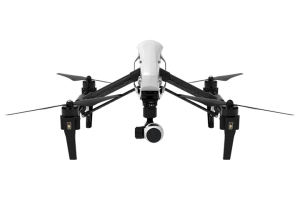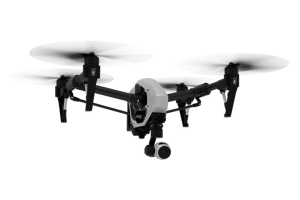New Inspire 1 model Review
New Inspire 1 model Review of the new UAV with a frame made from carbon fibre material and also innovative transformer style design. The UAV power voltage for the big 12″ size propellers, is also up from the Phantom series to a full 22.2 volts.
The new carbon fibre frame of the Inspire 1 is super light; the transform design is such that the frame structure opposed side arms move up when landing the craft, and they move down when in flight. This design feature frees the camera point of view well below the frame, allowing the camera to view and shoot 360 degrees. The weight of the craft overall is three times heavier than the Phantom series, total weight with the camera is 2935 g.
Inspire 1 in a landing position
See prices from here: DJI Inspire One Store.
Inspire 1 in a flight position
Aspire 1 is based on a modular Camera and Gimbal system.
The Inspire 1 Camera with a dual function, 12 MB photos and 4K video. The camera Gimbal is manufactured Zenmuse, the model is X 3. Camera model is FC350. It has a total of 12.4M Effective Pixels.
- The image max size is 4000×3000.
- ISO Range 100-3200. FOV (Field of View) 94° CMOS Sony EXMOR 1/2.3”
- The Lens: f/2.8 (20 mm equivalent) 9 Elements in 9 groups Aspherical lens element Anti-distortion filter UV filter.
- Still Photography Modes: Single shoot.
- Burst shooting (BURST: 3/5/7 frames,AEB: 3 or 5 bracketed frames at 0.7EV Bias).
- Time lapse.HD Video Recording Modes:UHD (4K): 4096x2160p24/25,
- 3840x2160p24/25/30
- FHD: 1920x1080p24/25/30/48/50/60
- HD: 1280x720p24/25/30/48/50/60
- Supported SD Card Types:SD/SDHC/SDXC Micro SD
- Max capacity: 64 GB. Speed: Class 10 or higher
Live HD view during UAV flight
The Inspire 1 allows for a real time feed from the onboard flight camera which is displayed in 720p HD on the mobile device on the ground. This enables a clear view of the object during the flight as the camera sees to maximise the angle and the distance of the video and images.
This is one new feature of the Aspire 1 which is made possible by the new and improved version of DJI’s Lightbridge technology. It can transmit video from up to 2000 meter distance.
Optional two controllers for a single flight; a flight pilot and a camera person to capture the action
For those that are not restricted by a small budget there is even greater expansion concept possible now, with the new updated technology for flight and camera control. It is the use a second remote controller, other than the flight pilot, the second person is a camera control person, dual controls with dual visual screens. This can improve the precision of the flight time, making the flight time more effective especially when doing a professional shoot of action sport, when the object of the shoot may only be in position for a matter of second and moving with great speed. E.g.: motor sports, skiing, snowboarding and surfing.
New Inspire 1 model Review Flight power management system
Aspire 1 is powered by a fully integrated intelligent battery and it virtually manages itself.
During in flight the battery power level is shown live, allowing to estimate the time line of the flight time, and also an DJI Aspire 1 advanced algorithms calculates the distance and the estimated time to return, and signals the time to fly back.
The intelligent battery tracks the voltage of each cell, the total lifetime charges and discharges, and the overall
health and battery status.
Standart Battery Name: Intelligent Flight Battery
Model: TB47
Capacity: 4500 mAh
Voltage: 22.2 V
Battery Type: LiPo 6S High voltage battery
Energy: 99.9 Wh
Net Weight: 570 g
New Inspire 1 model Review Climate condition variations.
I would reallu like to take the Inspire 1 for a test Flight here at the Nordic region, during the winter condition. I can only imagine how great it would be, to be chasing a snowboarder and a skiier down a tundra mountain side. Most likely it would need some winter climate proofing, to protect the battery and the motors from the cold. The temperatures early in the mornings, on clear day ( just the time when you want to fly) would be lower thatn the -10C. More likely to be between -15’C to -20’C. Obviously the preopellers and the motors would be the first point of impact for the cold. Second would be the battery power, twindling down, quickly in the sub zero temperature. Maybe there is a motor available that generates and pumps out heat to keep the vital components alive. Or even closing off any air vents and channeling that heat from the motors to a battery enclosure.
The speed of ascent according to DJI is 5 meters per second, that is relatively fast.
A controlled safe descent speed is 4 m/s, which translates from, 800 meters it will take some 20
seconds to descent down to the ground. The max speed is said to be 22 meters per second without any encouragement or restrictions from the wind of the natural elements. Max flight altitude is at 4500 meters. Which leaves Mount Everest, out of reach for the Inspire 1 flight altitude. The hot and the cold, operating temperature is to work between -10C to +40C. This would make an interesting test for the DJI Inspire in the Nordic region winter climate conditions.
Thank you for visiting and reading this New Inspire 1 model Review article here at Best Camera Drone web site, here is a link to the Best Camera Store web site below. Do visit and see the Inspire 1 UAV being advertised with up to date prices.
Visit the link below to a web site for more details.


